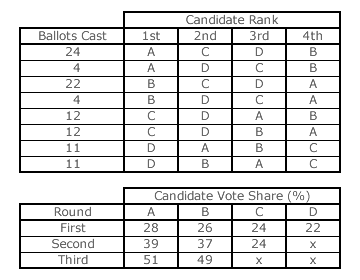Comparisons: Alternative Vote (Instant Run-Off Voting)
Description of the Alternative Vote
The alternative vote (AV) is also known as instant run-off voting (IRV). It is a preferential voting system that employs the same ranked ballots as used in CHPV and Borda Count elections. However, unlike positional voting systems, AV preferences are not associated with any weightings. Also, unlike Condorcet methods, the AV algorithm is not based on pairwise comparisons. Instead, the AV algorithm is based on the transfer of votes following the elimination of a candidate.
In the first round of counting, only the first preferences are tallied. If a candidate has a majority of the votes cast, then that candidate is the winner. If no winner emerges, then the candidate with the smallest tally is eliminated from the second round. The votes for the eliminated candidate are then transferred to the remaining candidates according to the second preferences of those voters. If a majority now exists, then the relevant candidate wins; else another round of counting is undertaken. This process of eliminating the least-preferred candidate in each round and redistributing their votes to the candidates next preferred by those voters continues until one candidate emerges with a majority of the votes and wins the election. For a more detailed and comprehensive description of the alternative vote, please visit the voting system section of Wikipedia or another reference source.
Properties of the Alternative Vote
AV clearly satisfies the majority criterion. However, it fails the monotonicity, consistency, participation and summability criteria. Also, the count is a time-consuming process as the summability order function is the factorial of N (N!). In other words, there can be up to N-1 rounds of counting with just one less candidate present each time in consecutive rounds. Further, the AV algorithm is not deterministic. In each round, two or more candidates may tie for last place. The random selection of one of these candidates for elimination means that a different candidate can be eliminated if the process is rerun. This also means that a different winner can emerge after the final round of counting. Although AV fails the Independence of Irrelevant Alternatives criterion, it does meet the Independence of Clones requirement so vote splitting and teaming do not occur.

For comparison with the other preferential voting systems in the preceding sections, the earlier four-candidate election example is repeated here. The 100 voters input the same ranked ballots as before but the outcome is now determined by the AV method; see tables opposite. In the first round, only the first preferences are tallied. No candidate has over 50% of the vote so a second round is required.
Candidate D is eliminated from this round as the tally of 22 votes is the smallest. Of these 22 voters, 11 chose A and another 11 chose B as their second preference candidate. Despite the increase (+11) in the tallies for A and B, still no candidate has over 50% of the vote so a further round is needed.
Candidate C currently has the lowest tally and is hence eliminated. The 24 voters awarding C their first preference also awarded D their second preferences. As D has already been eliminated, these 24 votes are transferred to the next-preferred candidates. The tally for A therefore rises by 12 to 51 and the tally for B increases by 12 to 49. As A now has a majority of the votes cast, candidate A is the winner.
The implicit candidate rankings may be deduced from the order of the eliminations. The earlier the elimination, the lower the candidate is in rank. Here, the ranking is A then B then C then D. The plurality system also produced this same result. This is not surprising since the first round in AV is equivalent to plurality. The two systems only differ when the candidate who gets a plurality of the vote does not achieve a majority. Even when more than one round of counting is required, AV still focuses on the higher preferences and typically ignores the lower ones. Indeed, the majority of all the preferences expressed by voters here are never used to determine the winner. Only 146 (100 + 22 + 24) out of the 400 (100 x 4) preferences (36.5%) affected the outcome despite the maximum number of counting rounds being required.
Therefore, like plurality, AV favours polarized candidates with strong yet narrow support over consensus candidates with broader but weaker support. However, in order to achieve a majority, all AV candidates must seek high-ranked as well as top-ranked preferences from the majority of voters. Also, unlike plurality, AV does not suffer from vote splitting. As Condorcet methods and the Borda Count favour consensus candidates, AV has little in common with these voting systems.
In comparison with AV, CHPV utilises each and every preference in determining the winner and candidate rankings. Many (but not all) of the voting system criteria that CHPV satisfy are not satisfied by AV. Similarly, many of those satisfied by AV are not satisfied by CHPV. Again, the two systems have little in common. While AV and plurality favour polarized candidates and with the Borda Count and Condorcet methods favouring consensus ones, CHPV is not biased towards either extreme but instead requires potential winners to seek both broad and strong support from the electorate.
Proceed to next section > Comparisons: Plurality Rule Methods
Return to previous page > Comparisons: Condorcet Methods 2
